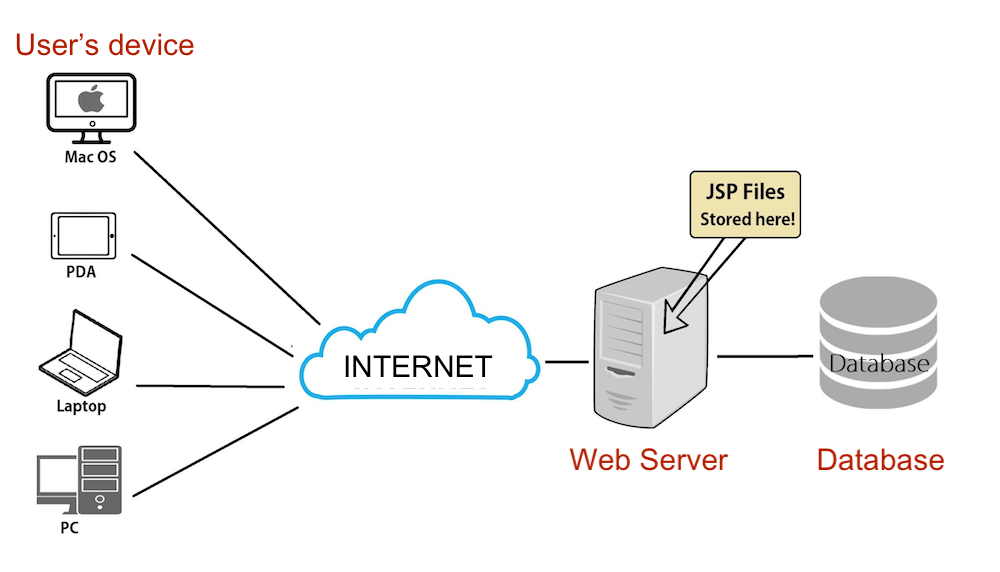In this article we briefly cover what a web application server is, what server applications are used for, and the most popular servers in 2023.
You’re probably reading this article on a screen. It appears to be easy to access this web page through most any device with a browser, simply and without a second thought. What’s happening behind this screen is of course much more complex. A key facet of this complex architecture is a web server.
What is a web server exactly? And what is the most popular one? Let’s investigate.

What Is a Web Server Application?
There are two key components of a web server: software and hardware. These work together to create a system that serves to process user requests seamlessly.
Web Server Software
The language most commonly used to communicate to the web browsers is the HTTP or HTTPS. These servers are known as HTTP servers. Imagine a database behind a veil, then imagine a fork or a prong with which you can retrieve data from behind the veil. The server determines what files the user can have access to and how. When a server enters a URL into a system, it begins to have access to the data stored under that URL. The server, in our case the HTTP server, sparks that beginning; processing the request the user put in to generate a response on the used web browser.
Web Server Hardware
The physical component of a server acts as a hub where the HTTP server and the data corresponding to that particular server is stored. Through a physical server, it becomes easy to make data transactions or exchanges across platforms over the internet. It may be likely that a website with high traffic would require a large number of physical servers.
To function, a web browser’s first requirement is to have a hosted file that can be delivered across systems through HTTP. When a user pushes for a certain hosted file, the command goes to the web server to process and retrieve the file in question.
Critical Steps
Hosting Files
The way to host files is to store them into the web server in the form of HTTP, JavaScript, CSS, images or videos. Ideally, the hosting process is handled by a web server that’s maintained by a hosting service provider. This not only makes it possible to remedy system problems, but also gives access to the hosting service provider’s resources such as CPU and RAM, to help improve web application or website security, increase uptime, diminish quality issues, and to maintain integrity with the customers.
HTTP Communication
HTTP allows for communication to happen in between different systems by giving a set of rules and processes. The most commonly used server is the HTTP or HTTPs, both of which allow user requests to be processed.
When the user enters a URL, the HTTP server proceeds to scan itself to see if any matching documents or resources exist within it. If there’s a match, the server sends it out to the user. If the server can’t find a match, it will generate a document. If none of these options are viable, then a 404 error is displayed to the user.
Static or Dynamic Web Content
There are two types of servers; static or dynamic.
- Static: This type of server uses HTTP and physical web server to deliver content to the user upon the user giving a request.
- Dynamic: A dynamic server hosts a static server within itself in addition to having access to a software that includes a database and an application server. In this, the dynamic server uses the database and the application server to generate content based on the requests sent in by the user. The delivery method is still HTTP.
An example is Wikipedia. Wikipedia contains some static templates and a large database rather than a stack of static HTML files. Upon a request from the user, the application server creates the content and plugs it into one of these templates. The template plus the content is then displayed to the user. The use of both, static, and dynamic servers to deliver content are impeccable to the function of any website.
The Most Popular Web Server Application: NGINX
NGINX is the most popular web server application at time of writing, with 32.29% of the web server market share. This per a report conducted by Netcraft–a UK-based internet services company.
There are two versions of NGINX. It has a high performing open-source component and a paid web server that contains more advanced features. This web server was released in 2014 and since then has captivated the market. Before NGINX, Apache had been the market leader, but after 2019, NGINX overpowered and drove through to become the number one holder of the market.
Advantages include:
- Being able to handle websites that have a large amount of traffic because this web server can hold up to 10,000 connections pretty seamlessly.
- Being compatible with the latest IP version, IPv6.
- Being able to act as a proxy that can retrieve data from more than one source.
- Being able to distribute load to the variety of servers available to it on the back-end to allow for processing during high volume times.
- Being able to withhold from processes running in the background by using an event-based system that uses less memory.
Popular Server Applications in 2023
The question, “What is the most popular server application?” has been answered courtesy of NGINX. But there are several others you should be on the lookout for.
Apache
Released in 1995, this web server is also a free server that can be used across platforms. Since it’s been around a long time, this application played a decisive role in the creation of early websites. Although Apache has lost some market share recently, it remains one of the two leading web servers, with over 23% of market share at time of writing. This application offers a stable future for projects at every scale.
Advantages
- A large collection of MultiProcessing Modules (MDMs) allowing for flexibility in terms of being able to cooperate with multiple architectural platforms
- Contains a large number of functionalities, thereby making it strong at its core
- Has a large online community which can be helpful in times of trouble
- Its compatibility with IPv6
OpenResty
This web browser uses the LuaJIT script to produce Lua scripts, and is based on NGINX architecture. This web server becomes useful when considering the scalability of web apps, gateways, and web services. In February 2022, over 10 million sites and 546,000 domains used this server, which suggests it has a strong future and increasing adoption.
Advantages
- Event-based architecture
- Uses NGINX’s core functions in its program, alongside LuaJIT and third-party modules that come equipped with NGINX software
- Useful for high-traffic websites that have multiple access points
Cloudflare
Cloudflare is among the top most popular web server applications. Following Apache and NGINX, Cloudflare holds approximately 19% of the market share. The predictions for this web server say that it will increase its market share in the near future since it’s used for high-traffic websites. An easy to set-up tool, Cloudflare provides the structure to build web apps without any need for additional hardware, changes in code, and changes in software.
Advantages
- Being able to remove unnecessary characters which helps reduce file size and in turn, reduces page load time.
- Helps reduce potential threats with DNSSEC
- Offers accelerated web browsing with the help of AMP (Accelerated mobile pages)
Internet Information Services (IIS) for Windows® Server
Internet Information Services (IIS) for Windows® Server is a Microsoft service established in 1995. High performance is its benchmark. It’s mostly used for static websites and is presented as a flexible, secure and manageable web server to host anything online, from web applications to media streaming at scale.
Advantages
- Comes with a modular structure which makes it easier to add, change or remove modules.
- Comes equipped with authentication services for added security
- Has a data manager to help with data upkeep and control
LiteSpeed
A proprietary web server, this initially came out in 2003 and was released by LiteSpeed Technologies. There are both, open-source and paid options available with this company. OpenLiteSpeed is the open-source version of this software and this slashes off several of the functions otherwise available under the paid version. The paid version also comes with licenses.
Litespeed promises to “double the maximum capacity of your current Apache servers with LiteSpeed Web Server’s streamlined event-driven architecture, capable of handling thousands of concurrent clients with minimal memory consumption and CPU usage.”
Advantages
- Its consumption of memory and CPU is quite low when taking the amount of functions it runs into consideration
- Uses the same architecture as Apache, therefore it’s compatible with many Apache features
- Event-based structure that responds to requests, therefore conserves resources
Web Server Application Monitoring
Given servers are the backbone of any website or web application, monitoring is essential for any serious business with an online presence. Read our top picks of web server application monitoring on our homepage.

